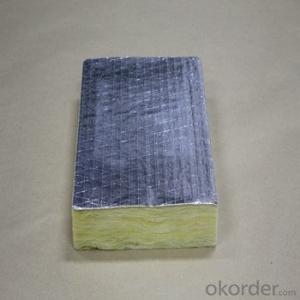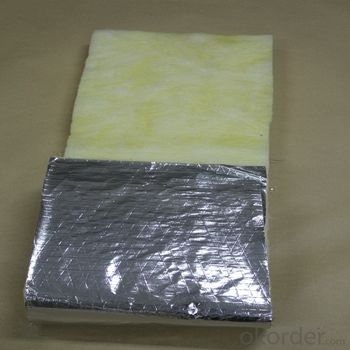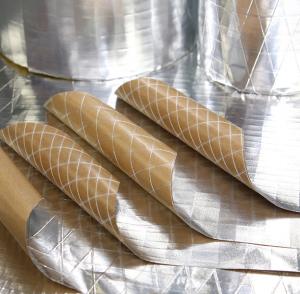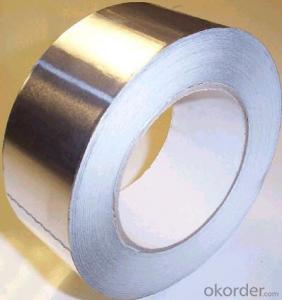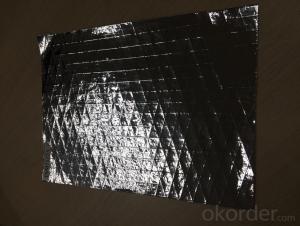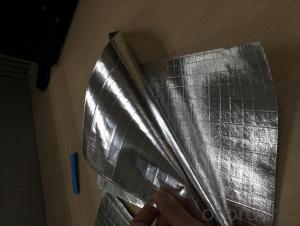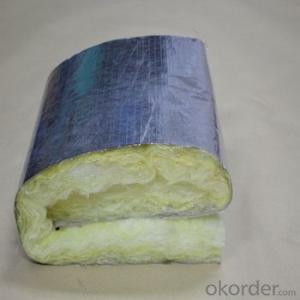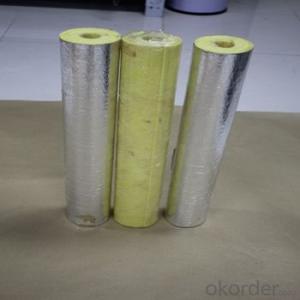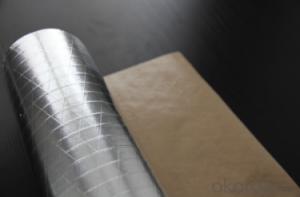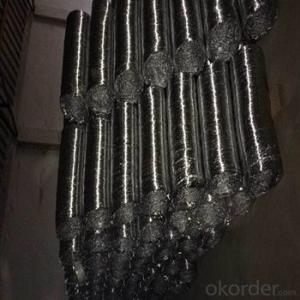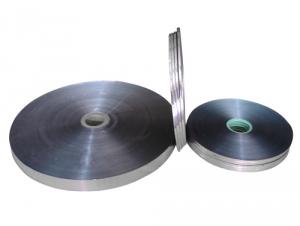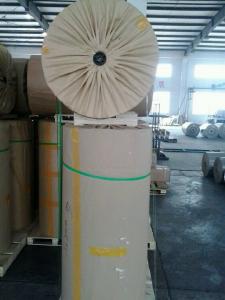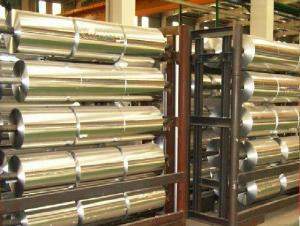Aluminum Foil FSK insulation facing for Glasswool and Rockwool
- Loading Port:
- Shanghai
- Payment Terms:
- TT OR LC
- Min Order Qty:
- 500 m²
- Supply Capability:
- 6000000 m²/month
OKorder Service Pledge
OKorder Financial Service
You Might Also Like
Specification
1. Aluminum Foil Facing Description:
The production technologies and products performance of aluminum foil facing have been up to international advanced level. The aluminum foil facing products are mainly used for HVAC system, refrigerators, building thermal aluminum foil facing insulation and laminated with glass wool and rock wool to increase the insulation function.
• Heat-sealing aluminum foil facing is used for duct wrap without applying extra adhesive and suitable for online lamination Glasswool.
2.Main Features of the Aluminum foil facing:
• Light weight
• Small inertia resistance
• High manufacturing accuracy
• Strong heat dissipation ability
• Good visual effect
3.Aluminum Foil Facing Images
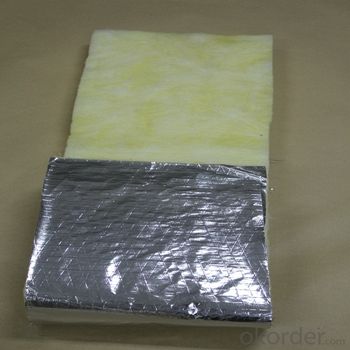
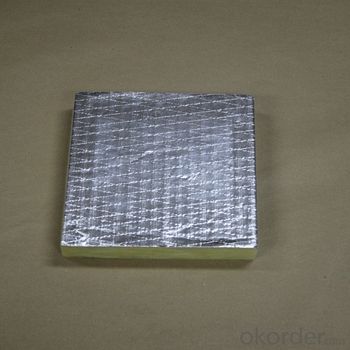

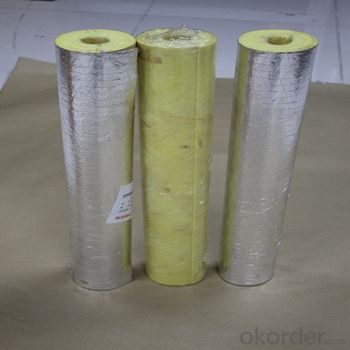
4.Aluminum Foil Facing Specification
Width: 1.0m, 1.2m, 1.25 m, 1.30, 1.37m
Length: 200m, 500m, 1000m, 2500m, 2750m, 3300m
Core I.D.: 3"(76mm ±1), 72mm ±1
Based on order, special sizes are also available.
5.FAQ
We have organized several common questions for our clients,may help you sincerely:
(1) How about your company?
A world class manufacturer & supplier of aluminum foil facing and is one of the large-scale professional investment aluminum foil facing bases in China. Annually more than 1000 containers of aluminum foil facing are exported to markets in Europe, America and Japan.
- Q: This question asks for methods to clean aluminum foil facing that has old food stains on it after cooking.
- <p>To remove old food stains from aluminum foil facing, start by scraping off any loose debris with a spatula or scraper. Then, soak the stained area in warm soapy water for about 15 minutes. Use a soft cloth or sponge to gently scrub the stains. For stubborn stains, make a paste of baking soda and water, apply it to the stain, and let it sit for a few hours before scrubbing. Rinse thoroughly with water. If stains persist, consider using a non-abrasive cleaner specifically designed for aluminum surfaces. Always test any cleaning solution on a small, inconspicuous area first to ensure it doesn't damage the surface.</p>
- Q: This question asks for the optimal method of storing aluminum foil to maintain its usability and prevent damage.
- <p>The best way to store aluminum foil is to keep it in a cool, dry place, away from direct sunlight and heat sources. It's advisable to store it in its original box or a resealable plastic container to prevent it from getting crumpled or damaged. Some people prefer to store it with the shiny side facing out for easier identification, while others prefer the dull side out to reduce glare. It's important to ensure that the foil is tightly rolled to prevent it from unraveling or getting tangled.</p>
- Q: What are the options available to replace aluminum foil when covering food?
- <p>Yes, there are several alternatives to aluminum foil for covering food. Silicone food covers are reusable, heat-resistant, and can be easily washed. Beeswax wraps are an eco-friendly option, made from natural materials and can be used multiple times. Parchment paper is a disposable option that's ideal for baking and can be used in place of foil. Reusable glass or ceramic lids can be used for dishes that need to be covered while cooking. Lastly, some people opt for reusable metal mesh covers, which are suitable for grilling and baking. Each alternative has its own benefits and is chosen based on the specific needs and preferences of the user.</p>
- Q: The user is asking if it's possible to use aluminum foil with a reflective side to cook a pot roast.
- <p>Yes, you can use aluminum foil with a reflective side to make a pot roast. Aluminum foil is a versatile tool in cooking and can be used to wrap the roast, helping to retain moisture and cook the meat evenly. Ensure the foil is heavy-duty to withstand the cooking process and avoid punctures. Remember to monitor the roast closely to prevent overcooking, and adjust cooking times and temperatures as needed.</p>
- Q: This question asks for guidance on preparing a nutritious meal using aluminum foil as a cooking method.
- <p>To make a healthy meal using aluminum foil, consider 'foil packet cooking'. Choose lean protein like chicken or fish, and pair it with a variety of colorful vegetables such as bell peppers, zucchini, and cherry tomatoes. Season with herbs, garlic, and a drizzle of olive oil. Fold the foil to create a sealed packet and bake in the oven at 400掳F (200掳C) for about 20-25 minutes or until the protein is cooked through and the vegetables are tender. This method retains nutrients and flavors while minimizing added fats.</p>
- Q: What are the primary applications or purposes of aluminum foil facing in various industries or everyday life?
- <p>Aluminum foil facing is primarily used for its heat reflective properties, making it ideal for insulation in construction and roofing. It also serves as a moisture barrier and vapor barrier in walls and ceilings, helping to prevent mold and mildew. In the HVAC industry, it's used for duct insulation, enhancing energy efficiency. Additionally, it's utilized in packaging for food and pharmaceuticals to protect contents from light, air, and moisture, thus preserving freshness and quality.</p>
- Q: Is it safe and hygienic to repurpose a piece of aluminum foil that was previously used for wrapping food?
- <p>It is generally not recommended to reuse aluminum foil that has been in contact with food. Used foil can have residues of food, grease, and bacteria, which can contaminate new food items. Additionally, the foil can tear or become thin in areas, reducing its effectiveness and potentially allowing food to stick to previously used, contaminated areas. For椋熷搧瀹夊叏 and hygiene, it's best to use a fresh piece of aluminum foil each time.</p>
- Q: This question asks for the optimal methods of preserving leftover food using aluminum foil.
- <p>The best ways to store leftovers using aluminum foil involve ensuring the food is cool before wrapping, covering the entire dish tightly, and sealing the foil properly. First, let the leftovers cool down to room temperature to prevent condensation. Then, wrap the dish completely with aluminum foil, making sure to cover the edges and corners to avoid air exposure. For added protection, you can double-wrap the dish. Seal the foil by pressing the edges together firmly. Store the wrapped leftovers in the refrigerator or freezer, depending on how soon you plan to consume them.</p>
- Q: Is it possible to use aluminum foil with a shiny side as a non-stick surface for cooking purposes?
- <p>Yes, you can use aluminum foil facing as a non-stick surface for cooking. The shiny side of aluminum foil is often used to create a non-stick surface, which can be helpful when grilling or baking to prevent food from sticking to the pan or grill. However, it's important to use it properly to avoid any potential health risks. Ensure that the foil doesn't touch the heat source directly for extended periods, as this can cause the foil to break down and release aluminum into the food. It's also recommended to use heavy-duty aluminum foil for cooking to ensure it can withstand higher temperatures without puncturing or melting.</p>
- Q: What are the potential health risks associated with the use of aluminum foil facing?
- <p>There are no significant health risks associated with the use of aluminum foil facing in everyday cooking and food storage. While aluminum is a common element and can be found naturally in many foods and water sources, the amount that might leach from foil into food is minimal and not considered harmful. However, it's always best to avoid wrapping acidic or highly salty foods in aluminum foil, as this might increase the potential for aluminum to leach into the food. For most people, the small amounts of aluminum that could come into contact with food from foil are not a health concern.</p>
Send your message to us
Aluminum Foil FSK insulation facing for Glasswool and Rockwool
- Loading Port:
- Shanghai
- Payment Terms:
- TT OR LC
- Min Order Qty:
- 500 m²
- Supply Capability:
- 6000000 m²/month
OKorder Service Pledge
OKorder Financial Service
Similar products
Hot products
Hot Searches
Related keywords
